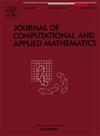近似时滞系统特征值的Tustin方法
IF 2.6
2区 数学
Q1 MATHEMATICS, APPLIED
Journal of Computational and Applied Mathematics
Pub Date : 2025-05-28
DOI:10.1016/j.cam.2025.116772
引用次数: 0
摘要
延迟微分方程(DDEs)特征值的数值逼近由于其对许多工业过程建模的影响而成为一个活跃的研究领域。本文介绍了一种基于Cayley变换的线性时不变(LTI)系统的新的数值方法Tustin方法。我们介绍了两种选择,一种使用三角基,另一种使用最大平滑的样条。对于样条,我们利用所谓的h-p-k精化,达到非常高的精度。我们证明了Tustin方法可以恢复所有的特征值,并给出了收敛速度的估计。我们对一般系统、大时滞系统和接近稳定边界的系统进行了数值实验。本文章由计算机程序翻译,如有差异,请以英文原文为准。
The Tustin Method for approximating eigenvalues of delay systems
Numerical approximation of eigenvalues of Delay Differential Equations (DDEs) is an active field of research due to its impact in the modeling of many processes of industrial interest. In this work we introduce the Tustin Method, a new numerical method for Linear Time-Invariant (LTI) systems based on the Cayley transform. We introduce two alternatives, one using a trigonometric basis, and other using splines with maximum smoothness. For splines, we exploit the so called -- refinement, achieving very high accuracy. We prove that the Tustin method recovers all the eigenvalues, and we give estimates for the rate of convergence. We make numerical experiments for generic systems, for systems with large delay, and for systems close to the stability boundary.
求助全文
通过发布文献求助,成功后即可免费获取论文全文。
去求助
来源期刊
CiteScore
5.40
自引率
4.20%
发文量
437
审稿时长
3.0 months
期刊介绍:
The Journal of Computational and Applied Mathematics publishes original papers of high scientific value in all areas of computational and applied mathematics. The main interest of the Journal is in papers that describe and analyze new computational techniques for solving scientific or engineering problems. Also the improved analysis, including the effectiveness and applicability, of existing methods and algorithms is of importance. The computational efficiency (e.g. the convergence, stability, accuracy, ...) should be proved and illustrated by nontrivial numerical examples. Papers describing only variants of existing methods, without adding significant new computational properties are not of interest.
The audience consists of: applied mathematicians, numerical analysts, computational scientists and engineers.

 求助内容:
求助内容: 应助结果提醒方式:
应助结果提醒方式:


